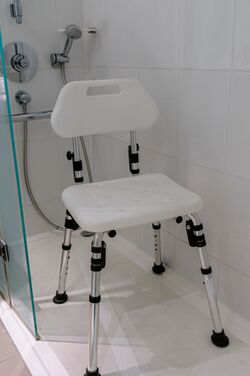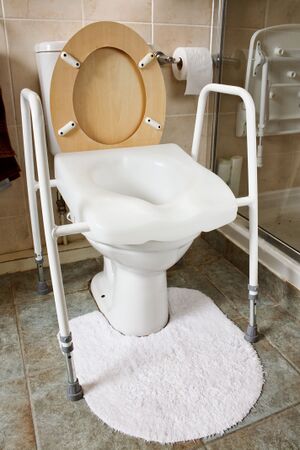Shower and Toilet Chairs
Intro[edit | edit source]
Mobility is a essential component required for activities of daily living (ADLs). Bathroom tasks such as toileting and showering can become difficult when mobility is limited. Research shows that elderly adults ranked showering as the most difficult ADL, with toileting the third most difficult. [1] The same article points out that people with disabilities and health care practitioners report the need for independent toileting to avoid feelings of loss self-esteem.[1] Bathroom adaptations through assistive technology can help individuals that have difficulty with toileting and showering. Various types of assistive technology for person hygiene and toileting including grab bars, nonslip mats, bath transfer benches and raised toilet seats.[2][1] Using assistive devices can increase independence, physical stability, confidence and safety.[3][1][2] In addition, assistive technology can decease the burden on caregivers and health care workers.[3]
Need for a shower and toilet chair[edit | edit source]
All populations from children to adults to the elderly can use a shower or toilet chair. Essentially anyone with a physical limitations such as the following may benefit from this type of assistive product.[4]
- difficulty standing or can not stand
- gets dizzy or tired during shower time
- at risk for falls or afraid of falling
- difficulty sitting down and standing up and/or squatting[4]
Shower Chairs[edit | edit source]
Shower stools and chairs are useful for individuals who need to sit down while washing themselves due to limited balance, strength or mobility. Components of a good shower stool or chair include the following elements:
- carry the weight of the user
- brakes if they have wheels; rubber stoppers if they have legs
- rust resistant
- water resistant
- durable and strong
- smooth finish
- Optional features:
- padding on seat
- armrests and backrests
- castor wheels with brakes[4]
- Optional features:
Toilet Chair[edit | edit source]
A raised toilet chair is helpful for individuals who have difficulty squatting or bending. This type of assistive product is typically placed over the existing toilet. Features that make a raised toilet chair beneficial and safe include the following:
- carry the weight of the user
- height adjustable legs
- brakes if they have wheels; rubber stoppers if they have legs
- rust resistant
- water resistant
- durable and strong
- smooth finish
- Optional features:
- padding on seat and armrests
- height adjustable armrests
- height adjustable and swing away footrests
- backrest with padding
- a removable bucket
- castor wheels that swivel or turn[4]
- Optional features:
Pressure Wounds[edit | edit source]
Before fitting someone with a shower or toilet chair, ensure they do not currently have or are at risk for a pressure wound. Someone with a current wound that would contact the chair should avoid using it until it is fully healed. Individuals at risk for a pressure would include:
- someone who had a previous wound
- someone with decreased sensation in things, back or buttocks
- someone who can not easily shift their weight
- a frail or thin individuals
At risk individuals should use a chair with a padded surface.[4]
Resources[edit | edit source]
- Shirley Ryan Ability Lab: 10 Tips from an OT to Make Your Bathroom Safer for Aging in Place
- My OT Spot: Our List of “Must-Know” Adaptive Equipment for OT Practitioners
- Dressing Aids
- Self-Care and Assistive Products
References[edit | edit source]
- ↑ 1.0 1.1 1.2 1.3 De-Rosende-Celeiro I, Torres G, Seoane-Bouzas M, Ávila A. Exploring the use of assistive products to promote functional independence in self-care activities in the bathroom. Plos one. 2019 Apr 8;14(4):e0215002.
- ↑ 2.0 2.1 Guay M, Latulippe K, Auger C, Giroux D, Séguin-Tremblay N, Gauthier J, Genest C, Morales E, Vincent C. Self-selection of bathroom-assistive technology: development of an electronic decision support system (Hygiene 2.0). Journal of medical internet research. 2020 Aug 10;22(8):e16175.
- ↑ 3.0 3.1 Meng H, Peterson LJ, Feng L, Dobbs D, Hyer K. The Use of Mobility Devices and Personal Assistance: A Joint Modeling Approach. Gerontology and Geriatric Medicine. 2019 Oct;5:2333721419885291.
- ↑ 4.0 4.1 4.2 4.3 4.4 World Health Organization. Training in Assistive Products (TAP). 2020. Available from https://www.gate-tap.org/all-modules/








